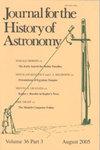G.B.里乔利的地心说运用了本轮、椭圆和螺旋
IF 0.3
3区 哲学
Q3 HISTORY & PHILOSOPHY OF SCIENCE
引用次数: 0
摘要
根据乔瓦尼·巴蒂斯塔·里乔利(1598-1671)的理论,行星以日心说的宇宙模型描述了在一个流动的天堂中的轨道。在他的著作《新星》(1651)中,他强调需要一种新颖而严格的天体运动几何解释,这种解释认为单独的原初运动是一个不必要的假设。里乔利拒绝了标准的偏心本轮理论,认为它不令人满意,并提出了他所谓的“偏心本轮”或“本轮”。他把开普勒椭圆理论考虑在内,包括了移动偏心中心和本轮直径变化的可变振荡。因此,行星沿着大小不一的螺旋轨道运行。天文学家们一直试图解释的不平等现在得到了证明:通过偏心中心的振荡得到的螺旋轨迹证明了第一个关于行星速度变化的不平等。由本轮直径的变化得到的螺旋振幅的变化,解释了第二个不等式,即行星明显的逆行或前进运动。在后来的著作《天文改革》(Astronomia Reformata, 1665)中,里乔利明确使用了“椭圆”一词。里乔利的创新非常有趣,有助于理解关于最佳世界体系的天文学辩论的复杂性。本文章由计算机程序翻译,如有差异,请以英文原文为准。
G.B. Riccioli’s geo-heliocentric use of Epicepicycles, ellipses and spirals
According to Giovanni Battista Riccioli (1598–1671), planets describe orbits in a fluid heaven in a helio-geocentric model of cosmos. In his Almagestum Novum (1651) he stresses the need for a novel and rigorous geometrical explanation for the motion of heavenly bodies, which considers a separate Primum Mobile as an unnecessary hypothesis. Riccioli rejects the standard eccentric-epicycle theory as unsatisfactory and argues for what he calls “Eccentrepicyclos” or “Epicepicycles.” He takes the Keplerian elliptical theory into account and includes a variable oscillation of both the mobile eccentric center and the variation of the epicycle’s diameter. As a result, planets move along spiral orbits that have variable sizes. The inequalities, which astronomers had always tried to explain, are now justified: the spiral trajectory, obtained by means of the oscillation of the eccentric center, warrants the first inequality, about the variation of the planets’ velocity. The variable amplitude of the spirals, obtained by the variation of the epicycle’s diameter, explains the second inequality, namely the apparent retrograde or progressive planetary motion. In the later work Astronomia Reformata (1665), Riccioli uses explicitly the term “ellipse.” Riccioli’s innovations are of great interest and help to understand the complexity of the astronomical debates about the best world-system.
求助全文
通过发布文献求助,成功后即可免费获取论文全文。
去求助
来源期刊

Journal for the History of Astronomy
地学天文-科学史与科学哲学
CiteScore
0.50
自引率
25.00%
发文量
44
审稿时长
>12 weeks
期刊介绍:
Science History Publications Ltd is an academic publishing company established in 1971 and based in Cambridge, England. We specialize in journals in history of science and in particular history of astronomy.
 求助内容:
求助内容: 应助结果提醒方式:
应助结果提醒方式:


